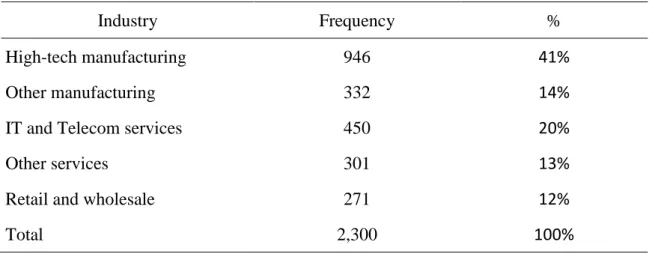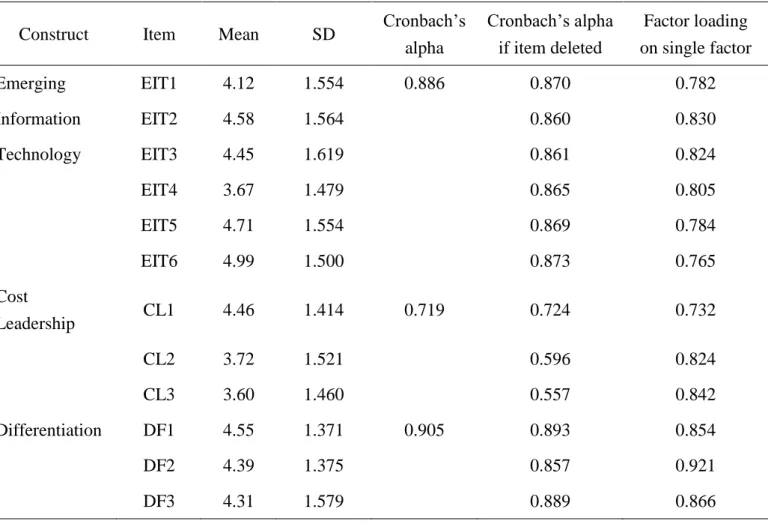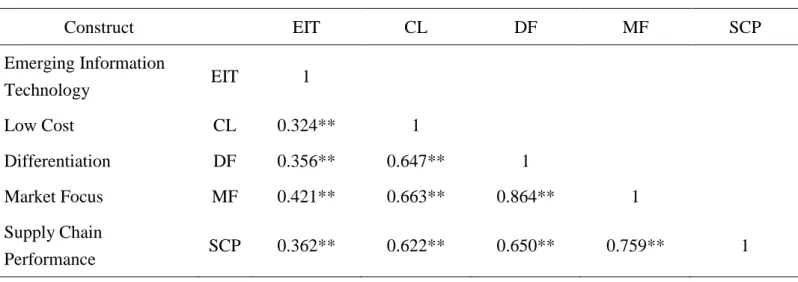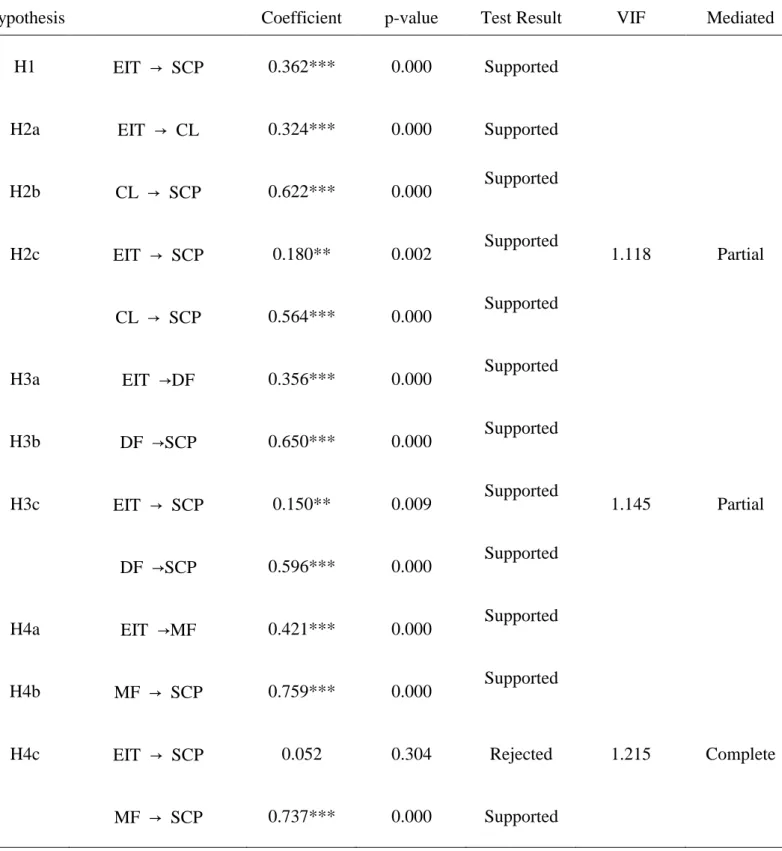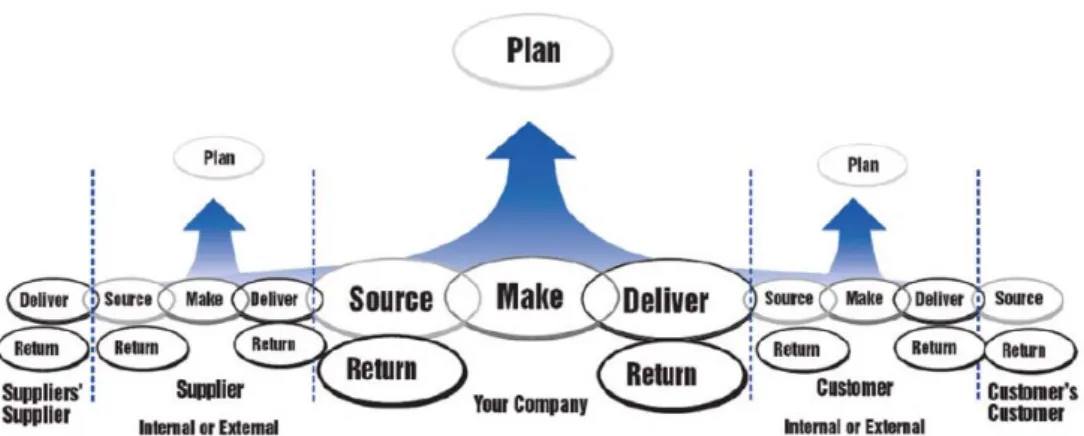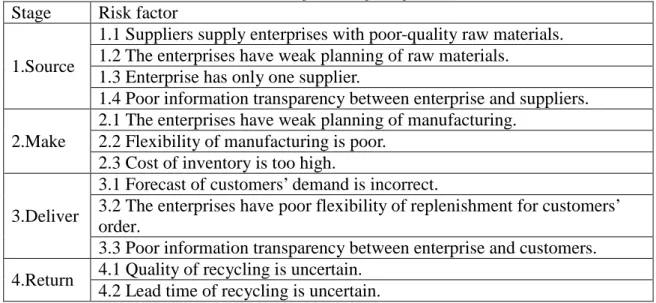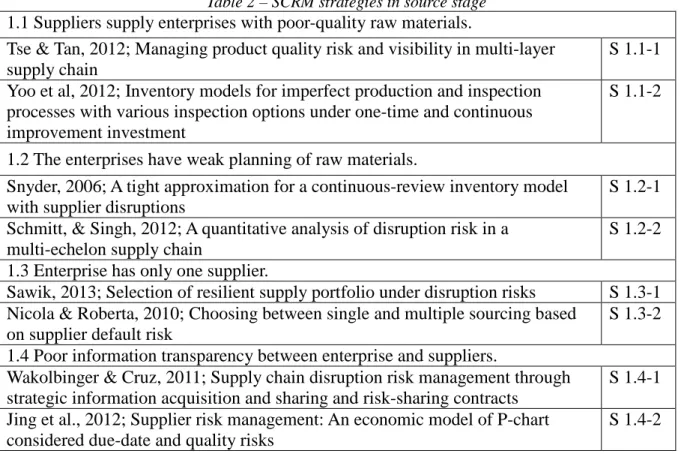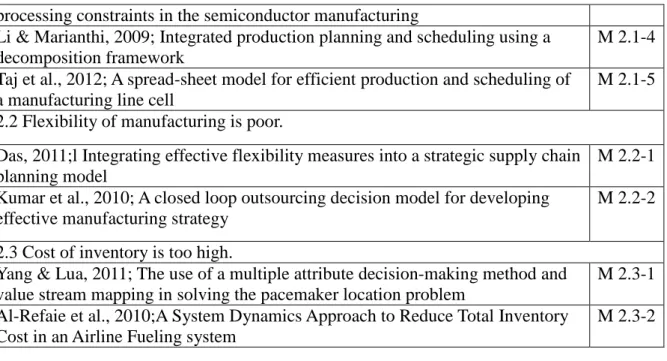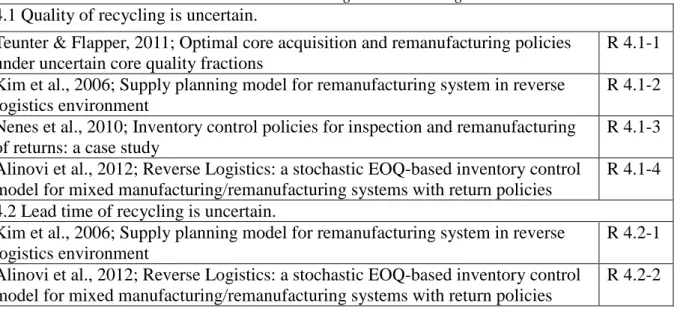科技部補助專題研究計畫成果報告
期末報告
應用於供應鏈管理上之新興軟體技術的選擇與運用策略研究
計 畫 類 別 : 個別型計畫 計 畫 編 號 : MOST 103-2410-H-004-110-執 行 期 間 : 103年08月01日至104年07月31日 執 行 單 位 : 國立政治大學資訊管理學系 計 畫 主 持 人 : 林我聰 計畫參與人員: 碩士班研究生-兼任助理人員:吳昀峰 博士班研究生-兼任助理人員:翁偉修 博士班研究生-兼任助理人員:方怡文 報 告 附 件 : 出席國際會議研究心得報告及發表論文 處 理 方 式 : 1.公開資訊:本計畫涉及專利或其他智慧財產權,2年後可公開查詢 2.「本研究」是否已有嚴重損及公共利益之發現:否 3.「本報告」是否建議提供政府單位施政參考:否中 華 民 國 104 年 10 月 07 日
中 文 摘 要 : 資訊科技的發展近況,引發了學界與產業界的關注;新興資訊科技 如雲端運算、巨量資料分析與行動應用等的蓬勃發展,不僅提供了 企業營運的新工具,也衝擊了如企業供應鏈管理等的企業管理層面 。然而,學者與企業管理者也持續對於應用這些新興資訊科技的實 際價值提出議論。因此,本研究將探討新興資訊科技應用對於供應 鏈績效的直接與間接影響。本研究運用「資源→策略→績效」模型 ,建構出以三種競爭策略(成本領導、差異化與聚焦)中介於新興 資訊科技應用影響供應鏈績效的研究架構,並透過企業問卷調查與 資料分析以進行各項研究假說的實證,及論述其管理意涵。 中 文 關 鍵 詞 : 供應鏈管理、新興資訊科技、雲端運算、巨量資料、行動應用、競 爭策略、資源基礎觀點
英 文 摘 要 : Information technology in recent developments has invoked tremendous attentions from both academics and industries. The emerging information technology such as cloud
computing, big data analytics and mobile application not only serves as a new tool for operations of enterprises, but also impacts management arenas of enterprises such as supply chain management. As considerable discussions about the real value of applying the emerging information
technology in academics and industries, this study researches direct and indirect impacts on applying the emerging information technology to the supply chain performance. By adoption of the
resource→strategy→performance model, this study builds a research framework in which three competitive strategies of firms cost leadership, differentiation and focus
-mediate the effect of applying emerging information technology on supply chain performance. Empirical survey and analysis of enterprise data is conducted to test our hypotheses, and managerial implications of findings are also further elaborated.
英 文 關 鍵 詞 : Supply chain management, Emerging information technology, Cloud computing, Big data, Mobile application, Competitive strategy, Resource-based view
I
摘要
資訊科技的發展近況,引發了學界與產業界的關注;新興資訊科技如雲端運 算、巨量資料分析與行動應用等的蓬勃發展,不僅提供了企業營運的新工具,也 衝擊了如企業供應鏈管理等的企業管理層面。 然而,學者與企業管理者也持續對於應用這些新興資訊科技的實際價值提出 議論。因此,本研究將探討新興資訊科技應用對於供應鏈績效的直接與間接影 響。 本研究運用「資源→策略→績效」模型,建構出以三種競爭策略(成本領導、 差異化與聚焦)中介於新興資訊科技應用影響供應鏈績效的研究架構,並透過企 業問卷調查與資料分析以進行各項研究假說的實證,及論述其管理意涵。 關鍵詞:供應鏈管理、新興資訊科技、雲端運算、巨量資料、行動應用、競爭策 略、資源基礎觀點II
Abstract
Information technology in recent developments has invoked tremendous
attentions from both academics and industries. The emerging information technology such as cloud computing, big data analytics and mobile application not only serves as a new tool for operations of enterprises, but also impacts management arenas of enterprises such as supply chain management.
As considerable discussions about the real value of applying the emerging information technology in academics and industries, this study researches direct and indirect impacts on applying the emerging information technology to the supply chain performance.
By adoption of the resource→strategy→performance model, this study builds a research framework in which three competitive strategies of firms - cost leadership, differentiation and focus - mediate the effect of applying emerging information technology on supply chain performance. Empirical survey and analysis of enterprise data is conducted to test our hypotheses, and managerial implications of findings are also further elaborated.
Keywords: Supply chain management, Emerging information technology, Cloud
computing, Big data, Mobile application, Competitive strategy, Resource-based view
III
Table of Contents
1. Introduction ... 1 1.1 Research Background ... 1 1.2 Research Motivation ... 1 1.3 Research Goals ... 2 2. Literature Review ... 32.1 Emerging Information Technology ... 3
2.2 Supply Chain Management ... 6
2.3 The Impact of Emerging Information Technology on Firms ... 6
3. Hypotheses Development... 9
3.1 The Impact of Information Technology on Supply Chain Performance ... 9
3.2 The Role of Competitive Strategy ... 10
4. Research Method ... 16
4.1 Survey Instrument ... 16
4.2 Sample and Data Collection ... 21
4.3 Reliability and Validity ... 22
5. Results ... 24 6. Discussion... 27 6.1 Managerial Implications ... 27 6.2 Study Limitations ... 27 6.3 Further Research ... 28 References ... 29
IV
List of Figures
Figure 1 Conceptual model ... 12
V
List of Tables
Table 1 Research variables ... 16
Table 2 Items used in the survey... 19
Table 3 Profile of the sampling firms ... 22
Table 4 Descriptive statistics and reliability and validity test ... 24
Table 5 Construct correlation... 25
1
1. Introduction
1.1 Research Background
Due to the high competitiveness of globalization in recent years, the meticulousness of
enterprise internationalization and business integration, and the rapid development of information
technology, business environments are experiencing tremendous change. For enterprises,
customers' requirements need more rapid response and fulfillment. In order to respond promptly to
the changing internal situations and external environments, enterprises need to interact quickly
between vendors of upper, middle and lower streams by means of information technology to form a
highly efficient supply chain organization.
In the meantime, the booming development of various emerging information technologies
such as cloud computing, big data and mobile application, are expected to affect enterprises’
managerial performance, including the supply chain performance. As the most noticed trends of
information technology development in recent years (Gartner, 2014, 2015; IDC, 2014, 2015;
IEEE, 2014, 2015), these emerging information technologies have attracted attentions as possible
sources to strategic advantages for firms (Porter & Heppelmann, 2014). Their influence on
economy and society has also attracted the attention of governments and companies worldwide.
The adoption of emerging information technologies can provide strategic advantages for
company managers and may even bring tremendous changes to the future market (Iansiti &
Lakhani, 2014). Therefore, aligning with the development trends of emerging information
technologies has become critical when companies develop their organizational strategies. Thus,
this study focuses on the managerial impact of innovative information technologies that emerge
in recent years (Gartner, 2015; IEEE, 2015; Porter & Heppelmann, 2014).
1.2 Research Motivation
The recent trends of information technology development center around the evolution of
2
applications (Gartner, 2015; IDC, 2015; IEEE, 2015). These emerging information technologies
(EIT) have also invoke tremendous attention from the academics (Iansiti & Lakhani, 2014; Porter
& Heppelmann, 2014). Facing this flourishing of emerging information technologies, how
enterprises react to these technologies becomes an important issue. The EITs are innovative
technologies and still under development. Their impacts on supply chain performance have not
been thoroughly realized, and deserved further investigation.
By now there is few rigorous research regarding the impact of the emerging information
technology on firm’s management activities and performance. Since supply chain management is
critical to firm’s operation and financial outcome (Qrunfleh & Tarafdar, 2014), this study will focus
on the influence of the emerging information technology on firm’s supply chain performance.
1.3 Research Goals
This study will explore the link between emerging information technologies and supply chain
performance, and investigate the mediators and moderators in the link. In this study, the sources→
strategy→performance scheme of competitive strategy (Day & Wensley, 1988; Venkatraman, 1989)
will be employed as a research framework. Empirical data from quantitative survey questions will
be collected and analyzed to realize the research hypotheses.
Through the research process and results, this study expects to clarify the effect of emerging
information technologies on supply chain performance, and also to identify possible mediators and
3
2. Literature Review
2.1 Emerging Information Technology
Recently, the emerging information technologies have attracted attentions as possible
sources to strategic advantages for firms (Porter & Heppelmann, 2014). Their influence on
economy and society has also attracted the attention of governments and companies worldwide.
Following the structure of the “new technology stack” depicted in Porter and Heppelmann
(2014), this study will focus on the emerging software technology embedded in the stack.
(1) Cloud
The innovation of cloud has made a major impact on the products, services and business
models of the IT software and hardware industries (Armbrust et al., 2010; Sultan, 2013; Vouk,
2008). Cloud computing has therefore become an emerging concept and technology that has
drawn attention from the IT software and hardware industries. The scope of the industry as well
as the fact that it spans both the enterprise and consumer markets has led to much discussion on
its future business potential (Graham, 2011; Iyer & Henderson, 2010; Katzan, 2009).
Nevertheless, cloud computing technologies and business models as well as the new products,
services, competition and alliances that arise as a result offer an emerging market that is well
worth monitoring (Helland, 2013).
Currently there are two main tracks of software technology in cloud infrastructure
management, virtualization technology and software defined network (SDN) technology.
Virtualization software is commonly used in the management and deployment of computing
infrastructure such as virtualizing server and storage devices. The technology has also been
extended to fields in desktop virtualization, application virtualization and internet virtualization
(Sotomayor et al., 2009).
On the other hand, rapid implementation of cloud related infrastructure and flexible
management of cloud data center has gain significance during the cloud development. Software
4
computing resources. Kim and Feamster (2013) discussed the concept and advancement of
software defined network as a promising technology for the management flexibility of data center
networking devices.
(2) Analytics and Big Data
“Big data” refers to the technology applied in big, immediate and manifold structured and unstructured information. It helps companies store, transform, transmit and analyze huge amounts
of information (McAfee & Brynjolfsson, 2012). It also provides advanced business analytics,
develops business intelligence and leads to gains in business values (Chang et al., 2014).
As the rapid growth of cloud computing, electronic commerce, social media, internet of things
and mobile devices, data volume grew explosively, and makes companies all over the world started
to pay attention to big data related technology (Kwon et al., 2014). Big data technology means to
use computing processes such as storing, transforming, streaming, transferring and analyzing to
handle structural or non-structural data that are dynamic, massive and variable, for the business
benefits (Jacobs, 2009). The use of big data is to perform instant and complex analysis to massive dynamic data, and support companies’ decision-making in a short period of time. The rise of big data has provided new opportunities for future ICT industries and data scientists (Jelinek & Bergey,
2013).
Chen et al. (2012) describe the evolution of Big Data technology. They use business
intelligence and analytics (BI&A) as a unified term, and treat big data analytics as a related field.
They argue that the evolution of Big Data technology is characterized by BI&A 1.0, BI&A 2.0
and BI & A 3.0. Data management and warehousing is considered the foundation of BI&A 1.0.
BI&A 2.0 systems require the integration of scalable techniques in text mining, web mining,
social network analysis, and spatial-temporal analysis with those existing DBMS-based BI&A 1.0
systems. BI&A 3.0 integrate Big Data technology with mobile applications, such as mobile BI,
mobile and sensor-based content, location-aware analysis, person-centered analysis,
context-relevant analysis and mobile visualization of data.
5
The Connectivity and Smart Mobile Applications software are used to establish exchange of
information in a mobile and ubiquitous way (Iansiti & Lakhani, 2014; Porter & Heppelmann,
2014). In order to provide ubiquitous mobile computing, infrastructure of wireless
communication network need to be constructed first. Currently, various networking infrastructure
are under development, such as IoT (Internet of Things) (Atzori et al., 2010) and wireless sensor
network (Piran et al., 2011).
Near Field Communication (NFC) (Leong et al., 2013; Tan et al., 2014) evolved from
Radio-Frequency Identification (RFID) (Ilie-Zudor et al., 2011) and interconnection technology.
In the past, non-contact chips were always produced as card applications. In recent years, chips
have been embedded into mobile devices for greater convenience. Mobile devices have therefore
been turned into a payment tool that allows downloading and payment of services in any public
setting and can also be used for exchanging data on mobile devices. This development extends
the possible applications of smart, connected products and the product clouds (Porter &
Heppelmann, 2014).
(4) Identity and Security
Porter & Heppelmann (2014) describes identity and security as “Tools that manage user
authentication and system access, as well as secure the product, connectivity, and product cloud layers.” This description of identity and security comprises cloud security and device security.
Cloud security software technology has two dimensions. One dimension is the adoption of
IT security technology, products or services by businesses to improve the security of cloud services. This is known as “Security for the Cloud” (Kalloniatis et al., 2013). The other dimension is the use of cloud computing by IT security vendors to strengthen, expand or transform their existing IT security technologies and services. This is known as “Security as a Service”. Examples include the collection of real-time virus data, updating virus definitions through the cloud, using cloud data centers for correlation analysis, reducing the load on terminal
computers and blocking malicious attacks before they can enter the corporate network. The goal
6
protect businesses from the IT security risks associated with the adoption of cloud architecture
(Subashini & Kavitha, 2011).
Device security involves Mobile Device Management (MDM) and Mobile Data Protection
(MDP). One controls physical mobile devices while the other secures data saved in mobile
devices, including user authority and privacy. BYOD (Bring Your Own Device) is currently the
main issue for many enterprises adopting mobile devices (Hancke et al., 2010; Shin et al., 2012).
2.2 Supply Chain Management
The goal of supply chain management (SCM) is to facilitate the efficient and effective
movement of products, services, finances, and information from a provider to a consumer. SCM is
not only essential for effective production, distribution, and logistical performance of today’s
companies, but can also influence their strategic posit (Vijayasarathy, 2010). Understanding how
firms can profit from their supply chain management is highly important for both management
practitioners and academics (DeGroote & Marx, 2013).
Prior research has characterized SCM as fundamentally reshaping the enterprise competition
and evolving as a part of firm’s new dominant logic (Wagner et al., 2012). Investigators have argued that the firm’s practices for leveraging associations with supply chain can be fundamental to sustaining a competitive advantage in the market (Qrunfleh & Tarafdar, 2014).
2.3 The Impact of Emerging Information Technology on Firms
In spite of the continuing development of the emerging information technology, research
regarding firms’ adoption, impact analysis and business strategy perspectives is still at its
embryonic stage (Porter & Heppelmann, 2014).
Gupta et al. (2013) exploit possible adoption considerations with cloud computing
technology. Factors that may influence adoption decisions of cloud computing, such as
7
& van de Bunt-Kokhuis, 2012). Garrison et al. (2012) investigated possible success factors for
deploying cloud computing. Cloud computing also introduces new risk into information
technology adoption. Subashini and Kavitha (2011) presented a survey of the different security
risks which pose a threat to the cloud.
Waller and Fawcett (2013) discuss potential impact of big data technology on firms. In their
paper, data science, predictive analytics and big data are collectively referred to as DPB. They
argue that data science is the application of quantitative and qualitative methods to solve relevant
problems and predict outcomes. Data scientists need deep domain knowledge and a broad set of
analytical skills. Predictive analytics is a subset of data science. Although predictive analytics is
related to many long-standing quantitative approaches, it stands as distinct from each. Predictive
analytics attempts to quickly and inexpensively approximate relationships between variables
while using deductive mathematical methods to draw conclusions. Chiang et al., (2012) argue that
the current state of the analytics software industry makes it difficult and cumbersome to conduct
analyses without a deep perspective of the underlying systems and technologies. They advocate
that BI&A should be an interdisciplinary area that integrates data management, database systems,
data warehousing, data mining, natural language processing, text mining, network analysis, social
networking, optimization, and statistical analysis.
The impacts of emerging connectivity and mobile application technology on firms are also
noticed. As mobile application software on mobile phones and tablets become more popular,
more development and deployment tool will be linked to the design and development of mobile
application software (Serrano et al., 2013). This trend will see more software developers release
innovative applications that link apps to SoLoMo (Social, Location based, Mobile) services,
creating new business opportunities for firms.
In view that the added value created by hardware products is limited, firms have gradually
transformed into investing in the development of mobile application software. In order to satisfy
8
the key source of competition for firms to differentiate their products (Mills et al., 2014; Watson
9
3. Hypotheses Development
3.1 The Impact of Information Technology on Supply Chain Performance
The possible impact of information technology (IT) on supply chain performance has been
an important topic to both academics and practitioners. For enterprises, the adoption of
information technology is geared to facilitate and enhance information processing and exchange.
The timely and accurate flow of information is a necessity for successful supply chain operations.
Therefore, information technology use in a supply chain is expected to produce positive results on
performance. For example, Wu et al., (2006) investigate the impact of information technology on
supply chain capabilities drawing from the resource-based view of IT. The findings suggest that
IT advancement and IT alignment are able to facilitate the development of supply chain
capabilities.
Zhang et al. (2011) conduct a systematic review of literature on the period of 1995 to
mid-2010 and find that a majority of papers confirm a positive relationship between IT and
supply chain performance.
For more recent research, DeGroote and Marx (2013) investigate the impact of information
technology on supply chain agility measured by the ability to sense and respond to market
changes. Their data are collected from supply chain executives at 193 U.S. manufacturing firms.
The results suggest that IT improves the supply chain’s ability to sense market changes by
improving the adequacy, accuracy, accessibility, and timeliness of the information flows among
members of the supply chain. Furthermore, IT also increases the supply chain’s ability to respond
to market changes by reducing the cost, and improving the quality and timeliness of developing
and executing coordinated plans to respond to market changes throughout the supply chain. Since
the information technology this study will focus on is the emerging information technology. It is
therefore hypothesized:
H1. There is a significant association between emerging information technology and supply
10 3.2 The Role of Competitive Strategy
Despite the research results of the significant impacts of information technology on supply
chain performance, it is argued that information technology alone does not completely determine
supply chain performance. Business strategic thinking also plays an important role towards supply
chain performance. For example, Huo et al. (2014) survey 604 Chinese manufacturers and find
competitive strategies significantly influenced the effectiveness of supply chain practices,
including internal, process and product integration.
Porter’s framework for competitive strategy is one of the most widely accepted business competition models (Miller, 1988). Porter’s research in industrial economics suggests three
generic strategies of competing above average rates of return: cost leadership, differentiation and
focus (Porter, 1980, 1985). He argues that to succeed in business, a firm needs to adopt one or
more of the three generic competitive strategies, and that the firm’s strategic choice ultimately
determines its competitiveness and profitability (Miller & Dess, 1993).
In the meantime, the resource-based view (RBV) (Wernerfelt, 1984) of the firm attribute
superior firm performance to firm resources. Firms build competitive advantage by utilizing unique
sets of resources and strategies (Barney, 1991). Resources enable firms to conceive and implement
strategies, improving effectiveness (Barney, 1991). In contrast, strategies are the ways in which
firms relate to their environment (Porter, 1980, 1985). Strategies therefore impact the link between
resources and performance (Edelman et al., 2005).
Day and Wensley (1988) extend the work of Porter (1980) by introducing the sources→
positions→performance (SPP) framework of competitive advantage. In addition to acknowledging
the performance impact of positional advantages in terms of superior customer value (e.g.,
differentiation) and lower relative costs (e.g., cost leadership). Their framework embraces elements
from the resource-based view (Wernerfelt, 1984) by arguing that organizational capabilities are the
11
Bharadwaj (2000) develops the concept of Information Technology as an organization
resource by drawing on the resource-based view of the firm. The study empirically examines the
association between IT resource and firm performance and finds the relationship to be positive and
significant.
Koo et al. (2004) investigate Porter’s competitive strategies in electronic virtual markets. In
their research framework, the resource of a firm is on-line business capability. Porter’s framework
of competitive strategies is used to compare the market strategies of on-line firms and firms
operating concurrently in the traditional and electronic markets. They also examine the connection
between the competitive strategies and business performance in electronic markets.
Edelman et al. (2005) provide a schematic representation of the resources → strategy →
performance model. They examine the relationship between firm resources, strategies, and
performance in a cross-section of small firms. They model firm strategy as a mediating variable by
arguing that mediation tests specify the existence of a significant intervening mechanism (e.g., firm
strategy) between an antecedent variable (e.g., firm resources) and the consequent variable (e.g.,
firm performance).
Reimann et al. (2009) draw from the sources→positions→performance framework and build a
research model in which two strategic postures of firms - differentiation and cost leadership -
mediate the effect of CRM on firm performance. Their results reveal that CRM does not affect firm
performance directly. Rather, the CRM-performance link is fully mediated by differentiation and
cost leadership.
In this research, the emerging information technology is viewed as sources of competitive
advantage to supply chain performance (DeGroote & Marx, 2013; Dong et al., 2009; Vijayasarathy,
2010). The basic premise of our study is that the relationship between emerging information
technology use in the supply chain and supply chain performance can be affected by three key
12
Figure 1 Conceptual model
(1) Cost Leadership
With a cost leadership strategy, a firm can improve its competitive stance by lowering its
manufacturing and marketing costs. A lower cost structure can improve profitability and market
share.
The advent of the emerging information technology has complicated the market dynamics,
making it harder to predict how firms will compete in the market (Porter & Heppelmann, 2014).
By now there are few studies of how companies compete in a market in terms of EST can be
related with cost leadership strategy. However, previous studies have shown that the integration
of information technology with supply chain management can reduce the cost of information
exchange between parties in the supply chain, and thus impacting the supply chain performance
(Dong et al., 2009; Qrunfleh & Tarafdar, 2014).
Therefore, we propose that emerging information technology indirectly affects firm
performance by increasing efficiency and driving down costs, implying that emerging information
technology significantly affects a firm’s cost leadership position, leading to superior supply chain
performance. It is thus hypothesized:
H2a: There is a significant association between intention use of emerging information
technology and position of cost leadership strategy.
Emerging Information Technology Supply Chain Performance Competitive Strategy
13
H2b: There is a significant association between cost leadership strategy position and supply
chain performance.
H2c: Cost leadership mediates the relationship between emerging information technology and
supply chain performance.
(2) Differentiation
On the other hand, a firm may pursue a strategic advantage by differentiating its products
and services from those offered by competitors. By providing unique and innovative products and
services with creative marketing, a firm can establish strong brand recognition and customer
loyalty.
With a differentiation strategy, a firm seeks to be unique in the way it offers products and
services to customers, because it is viewed as valuable by customers (Porter, 1980). Porter and
Millar (1985) further envisioned the potential of information technology as a driving force behind
differentiation strategies. Many believe that firms can also enhance value by creatively exploiting
differentiated market segments and channels. Differentiation strategies in market allow firms to
charge premium prices for products and services deemed unique by customers (Porter, 2001).
Adoption of information technologies may enable a firm to obtain in-depth information about
its suppliers and customers and then use this knowledge to adapt its offerings to meet the needs of
its supply chain operations in a better way than does its competitors. Therefore, the emerging
information technology is linked to the business strategy of differentiation, which enables firms to
achieve superior performance. This link is consistent with the sources→positions→performance
framework; emerging information technology is as the source that allows firms to achieve a
differentiated position, and in turn drives firm’s supply chain performance (Day and Wensley
1988).
H3a: There is a significant association between intention use of emerging information
14
H3b: There is a significant association between differentiation strategy position and supply
chain performance.
H3c: Differentiation mediates the relationship between emerging information technology and
supply chain performance.
(3) Focus
An alternative strategy, focus, is generally held to be appropriate for small firms or
entrepreneurs with few resources, because it allows them to compete with larger firms and
position themselves based on other strategic strengths (Wright, 1987).
With a focus strategy, a firm concentrates its efforts on a specific market segment (Porter,
1980). This strategy is generally held to be appropriate for small firms with few resources,
because it allows them to compete with larger firms and position themselves based on other
strategic strengths (Wright, 1987). How this strategy would play in an IT based market is not
clear. Further, there have been no extensive empirical studies of the behavior and performance of
firms in the market competing on the basis of information technology. Koo et al. (2004) examine Porter’s competitive strategies in electronic virtual markets and find on-line firms incline to differentiation strategy, whereas click-and-mortar firms prefer strategies based on focus strategy.
Both on-line firms and click-and-mortar firms are pioneer adopters of emerging information
technologies such as cloud computing and big data analytics. We thus hypothesize:
H4a: There is a significant association between intention use of emerging information
technology and position of focus strategy.
H4b: There is a significant association between focus strategy position and supply chain
performance.
H4c: Focus mediates the relationship between emerging information technology and supply
15
Drawing from these hypotheses proposed above, the research framework is illustrated in
Figure 2.
Figure 2 Research framework Emerging Information Technology Differentiation Supply Chain Performance Cost Leadership Market Focus H1 H2c H3c H4c H2a H2b H3a H4a H3b H4b
16
4. Research Method
4.1 Survey Instrument
The survey instrument is developed with questions derived from the literature on emerging
information technologies, Porter’s competitive strategies, resource → strategy → performance
framework, and supply chain performance discussed above. We operationalize the study variables
using multi-item reflective measures on a seven-point scale (Jarvis et al. 2003).
Table 1 summarizes the independent and dependent variables, which are further elaborated
below.
Table 1 Research variables
Construct Operational Definition Supporting Literature
Emerging information technology
A firm’s intention to adopt the emerging information technology
Armbrust et al. (2010); Cegielski et al. (2012)
Cost leadership
A firm’s posture of competition based on lower cost of operation and resource relative to the firm’s competitors.
Koo et al. (2004) Reimann et al. (2009) Oltra and Luisa Flor (2010)
Differentiation
A firm’s ability to compete by being unique within their industry in a number of perspectives.
Koo et al. (2004) Reimann et al. (2009)
Focus
A firm’s ability to compete by targeting specific groups of buyers, product lines, product lifecycle, or geographic areas.
Koo et al. (2004) Kim et al. (2004)
Supply chain performance
A firm’s assessment of the efficiency and effectiveness of its supply chain.
Wu et al. (2006) Vijayasarathy (2010) DeGroote and Marx (2013)
17
(1) The “Emerging information technology” construct
Emerging information technology is measured with five items that reflected the firm’s
intention to adopt the technologies. These items are based on technology forecast reports of famous
market research institutions and academic literature. Global market research firms such as Gartner
(2014, 2015) and IDC (2014, 2015) publish top technology trend predictions annually. Academic
society such as the IEEE Computer Society also announces annual top 10 technology trends (IEEE,
2014, 2015). Following the structure of the “new technology stack” depicted in Porter and
Heppelmann (2014), this study will focus on the emerging information technology items in the
technology stack.
We choose to measure intention rather than actual adoption of the technology due to the
relative newness of the emerging information technology as a business tool. In the literature, there
is extensive support for the notion that measuring intention, when placed in context with respect to
time, is an accurate proxy for action (Cegielski et al., 2012).
(2) The “Cost leadership” construct
The cost leadership construct is measured with three items that reflect the extent to which a
firm deploys a cost oriented strategy. First of all, cost leadership means the generation of higher
margins than competitors by achieving lower operation costs. Firms with a cost leadership
strategy often have highly stable product lines and a strong emphasis on profit and budget
controls (Miller, 1988). Secondly, cost leadership is often reflected in the price competitiveness
(Koo et al., 2004). The third item is the economic scale. A firm can gain a cost advantage with
economies of scale or superior manufacturing processes (Porter, 1980, 1985). Generally, larger
firms with greater access to resources are more likely to take advantage of cost leadership
strategies, whereas smaller firms are often forced to compete with highly differentiated products
18
(3) The “Differentiation” construct
The differentiation construct is measured with four items that reflect the extent to which a firm
deploys a differentiation strategy.
First of all, differentiation entails being unlike or distinct from competitors, e.g., by
providing superior information, prices, distribution channels, and prestige to the customer (Porter,
1980). Differentiation prevents a business from competitive rivalry, insulating it from competitive
forces that reduce margins (Phillips et al. 1983).
Extending Porter’s competitive strategy framework, Miller distinguished differentiation strategies based on innovation from those based on operational and marketing efficiency (Miller,
1988; Wright, 1987). These form the two items included in the construct.
Differentiation strategies based on innovation can create a dynamic market environment in
which it is hard for competitors and customers to predict and react. This unpredictability could
give the innovator a substantial advantage over its competitors (Miller, 1987). We further
distinguish innovation as new markets and new business models. Differentiation strategies based
on innovation can create a dynamic market environment or a distinct business model in which it
is hard for competitors and customers to predict and react. This unpredictability could give the
innovator a substantial advantage over its competitors (Miller, 1987).
(4) The “Focus” construct
We base our measure of the focus construct on the research construct of Koo et al. (2004),
and Laosirihongthong et al. (2010).
A firm may obtain a strategic advantage by choosing to become specialized and focus on a
niche market instead of competing broadly in the whole market. The choice of market segment
for focusing can be based on dimensions such as prices, customer groups, product functions and
19
market orientation, customer focus and product focus in the case business. We measure the focus
construct with four items which reflect four different market and product segmentations
(5) The “Supply chain performance” construct
Supply chain performance served as the dependent variable and is measured by seven items.
Respondents will be asked to rate their supply chain performance over the past few years relative to
their competitors on a seven-point scale.
Beamon (1999) proposed a framework for measuring supply chain performance. The
framework included the measurement of resources, output and flexibility as the strategic goals of
SCM. The key measuring variables include cost, activity time, customer responsiveness and
flexibility. Neely et al. (1995) discuss design issues in supply chain performance measurement
systems. The metrics and measures are also discussed in the context of supply chain
activities/processes such as plan, source, make/assemble, and delivery/customer (Gunasekaran et
al., 2001; Gunasekaran et al., 2004).
This study will focus specifically on supply chain effectiveness (the achievement of specific
objectives) and efficiency (the means by which specific objectives were attained), which have
been recognized as direct and observable goals of SCM practice. Firms in a supply chain achieve
operational efficiency and effectiveness by lowering costs, reducing inventory, promoting
flexibility, ensuring on-time deliveries, and minimizing shortage of critical resources. These
objectives relate to both parties in a buyer–supplier relationship, and therefore, can determine the
performance of the overall supply chain.
Table 2 presents the items used to measure each of the independent and dependent variables.
Table 2 Items used in the survey
Variable Item
Intention of emerging information technology adoption (1 – to no extent; 4 – to some extent; 7 – to a great extent)
20
EIT2: IoT sensing
EIT3: IoT big data analytics
EIT4: IoT user interface
EIT5: IoT mobile app
EIT6: IoT security and privacy
Cost Leadership strategy orientation (1 – strongly disagree; 7 – strongly agree)
CL1: Developing products or services with lower cost
CL2: Delivering products or services with lower price
CL3: Providing products or services in large quantity or scale
Differentiation strategy orientation
(1 – strongly disagree; 7 – strongly agree)
DF1: Differentiating products and services based on operational efficiency
DF2: Differentiating products and services based on innovation
DF3: Delivering products or services with superior functionality in current market
DF4: Delivering products or services with innovative business model
Focus strategy orientation
(1 – strongly disagree; 7 – strongly agree)
MF1: Focusing in a niche market segment
MF2: Focusing in first to market position
MF3: Focusing in market position as a fast follower
MF4: Focusing in a mature market segment
Supply Chain Performance
21
SCP1: Delivering products or services on time
SCP2: Reducing lead time
SCP3: Responding to changes of customer requirement
SCP4: Avoiding lack of critical resources
SCP5: Inventory and logistics flexibility
SCP6: Reducing cost of the whole supply chain management
SCP7: Reducing inventory cost
4.2 Sample and Data Collection
Empirical data to test the hypothesized relationships is obtained by using a survey of large
Taiwanese companies. An online questionnaire developed in accordance with Table 2 above is
implemented as the survey instrument. It is pre-tested in an iterative manner among a sample of 15
executives and supply chain managers. The questionnaire items is revised on the basis of results of
the expert interviews and refined through rigorous pre-testing to establish content validity. The
pre-testing focuses on instrument clarity, question wording and validity. During the pre-testing,
members of the sample are invited to comment on the questions and wordings of questionnaire. The
comments of these individuals then provide a basis for revisions to the construct measures.
After the pre-testing and revision, data of this research will be collected through an online
survey of supply chain executives and managers. China Credit Information Service, LTD (CCIS)
provides comprehensive data of the Top 5,000 list of the largest companies in Taiwan, and 2,300
firms are selected randomly as the sample of this study.
Table 3 shows the profile of the sampling list. The list for this research provides the names,
addresses, and e-mail addresses of the 2,300 randomly chosen members. Survey invitations are sent
to firms in the list by e-mail. Follow-up letters are sent approximately one month after the initial
22
Table 3 Profile of the sampling firms
Industry Frequency %
High-tech manufacturing 946 41%
Other manufacturing 332 14%
IT and Telecom services 450 20%
Other services 301 13%
Retail and wholesale 271 12%
Total 2,300 100%
4.3 Reliability and Validity
The reliability of the survey instrument will be tested using Cronbach’s alpha (Cronbach,
1951) as a test of internal consistency for the Emerging Information Technology, Cost Leadership,
Differentiation, Focus, and Supply Chain Performance constructs. Cronbach’s alpha tests the
interrelationship among the items composing a construct to determine if the items are measuring a
single construct. Nunnally and Bernstein (1994) recommend a threshold alpha value of .7. Cicchetti
et al. (2011)suggest the following reliability guidelines for significance: r < .70 (unacceptable), .70 ≤ r < .80 (fair), .80 ≤ r < .90 (good) and r > .90 (excellent).
Content validity (Straub, 1989) refers to the extent to which the instrument measures what it is
supposed to measure. Most of the measures used in the study are adopted from published studies on
the topics. Although basing the study on the established literature provided a considerable level of validity, the study’s validity will be further improved by pilot-testing the instrument with a panel of experts comprising 15 executives and supply chain managers.
In order to assess convergent and discriminant validity, the items used to measure Emerging
Information Technology, Cost Leadership, Differentiation, Focus, and Supply Chain Performance
23
sphericity and the Kaiser–Meyer–Olkin measure of sampling adequacy are tested for satisfactory,
24
5. Results
This study will investigate the impact of emerging information technology on supply chain
performance, mediated by the firm’s position of competitive strategy. The empirical results are
expected to demonstrate that emerging information technology such as cloud computing, big data
and mobile connectivity (Iansiti & Lakhani, 2014; Porter & Heppelmann, 2014) influences the
supply chain performance such as reducing cost, increasing flexibility and shortening time. The
results also will verify the mediating role of Porter’s theory of generic strategy (Porter, 1980, 1985)
on the link between emerging information technology and supply chain performance. Finally, these
results will also make a solid case for the the sources→strategy→performance framework of
competitive strategy (Day & Wensley, 1988; Venkatraman, 1989).
Table 4 summarizes the descriptive statistics, reliability and validity tests.
Table 4 Descriptive statistics and reliability and validity test
Construct Item Mean SD Cronbach’s
alpha Cronbach’s alpha if item deleted Factor loading on single factor Emerging EIT1 4.12 1.554 0.886 0.870 0.782 Information EIT2 4.58 1.564 0.860 0.830 Technology EIT3 4.45 1.619 0.861 0.824 EIT4 3.67 1.479 0.865 0.805 EIT5 4.71 1.554 0.869 0.784 EIT6 4.99 1.500 0.873 0.765 Cost Leadership CL1 4.46 1.414 0.719 0.724 0.732 CL2 3.72 1.521 0.596 0.824 CL3 3.60 1.460 0.557 0.842 Differentiation DF1 4.55 1.371 0.905 0.893 0.854 DF2 4.39 1.375 0.857 0.921 DF3 4.31 1.579 0.889 0.866
25 DF4 4.21 1.456 0.870 0.895 Market Focus MF1 4.52 1.379 0.852 0.806 0.839 MF2 4.31 1.485 0.812 0.834 MF3 4.32 1.311 0.835 0.792 MF4 4.22 1.372 0.792 0.864 Supply Chain Performance SCP1 4.51 1.460 0.931 0.926 0.795 SCP2 4.61 1.330 0.918 0.858 SCP3 4.94 1.338 0.917 0.866 SCP4 4.55 1.330 0.921 0.832 SCP5 4.55 1.396 0.917 0.868 SCP6 4.42 1.465 0.922 0.828 SCP7 4.64 1.338 0.920 0.847
Table 5 summarizes the correlation among different factors.
Table 5 Construct correlation
Construct EIT CL DF MF SCP Emerging Information Technology EIT 1 Low Cost CL 0.324** 1 Differentiation DF 0.356** 0.647** 1 Market Focus MF 0.421** 0.663** 0.864** 1 Supply Chain Performance SCP 0.362** 0.622** 0.650** 0.759** 1 **p < 0.01
26
Table 6 Tests of hypothesized model
Hypothesis Coefficient p-value Test Result VIF Mediated
H1 EIT → SCP 0.362*** 0.000 Supported
H2a EIT → CL 0.324*** 0.000 Supported
H2b CL → SCP 0.622*** 0.000 Supported
H2c EIT → SCP 0.180** 0.002 Supported 1.118 Partial
CL → SCP 0.564*** 0.000 Supported
H3a EIT →DF 0.356*** 0.000 Supported
H3b DF →SCP 0.650*** 0.000 Supported
H3c EIT → SCP 0.150** 0.009 Supported 1.145 Partial
DF →SCP 0.596*** 0.000 Supported
H4a EIT →MF 0.421*** 0.000 Supported
H4b MF → SCP 0.759*** 0.000 Supported
H4c EIT → SCP 0.052 0.304 Rejected 1.215 Complete
MF → SCP 0.737*** 0.000 Supported
27
6. Discussion
This study investigates the impact of emerging information technology on supply chain performance, mediated by the firm’s position of competitive strategy. Managerial implications and possible avenues for further research are elaborated as follows.
6.1 Managerial Implications
Supporting these research hypotheses, the critical insight we obtain from our empirical
results is that the link between emerging information technology and supply chain performance is
fully mediated by the strategies of firms. In other words, the link between emerging information
technology and supply chain performance is not direct, but rather indirect. On the basis of this
finding, we conclude that prior research was incomplete in that it focused exclusively on the
direct effect of emerging technology. By adopting a mediational structure in this study, we isolate
the specific processes by which emerging information technology links to supply chain
performance. To the best of our knowledge, this is the first empirical study to investigate critical
mediators in the technology-performance link as well as to examine emerging information
technologies in the context of business strategies.
6.2 Study Limitations
Although this study reports meaningful implications toward the development of
multidimensional measures of factors that influence supply chain performance, the validity of an
instrument cannot be firmly established on the basis of a single study. Especially, all cases used
for tests were collected in firms located in Taiwan. Taiwan is a relatively speedy and competitive
arena for accepting new information technology, but it has difference dependent on industry.
Especially, the manufacturing and retail industries have shown front-running features. It is
appropriate for SCM practitioners and academicians to interpret our findings as a guide model,
28 6.3 Further Research
As has been implied, there is a need for further research efforts focused on accumulating
empirical evidence for the validation and assessment of measurement properties and data
surmounting the limitations of the present study. Such research is needed to address how other
variables relate to supply chain performance. Wearable interface in IoT, for example, has received
inadequate attention in MIS and technology innovation theories. Further research could also
investigate the relative importance of the factors impacting each stage of the supply chain
process. These efforts should involve studies identifying the organizational factors which affect
such independent variables as process fit, information quality, and system support. Also, special
attention should be focused on data collected in various industries or specific context over an
extended period. The analysis of such data may enable conclusions to be drawn about both more
29
References
Armbrust, M., Stoica, I., Zaharia, M., Fox, A., Griffith, R., Joseph, A. D., & Rabkin, A. (2010). A
view of cloud computing. Communications of the ACM, 53(4), 50.
doi:10.1145/1721654.1721672
Atzori, L., Iera, A., & Morabito, G. (2010). The Internet of Things: A survey. Computer Networks,
54(15), 2787-2805. doi:10.1016/j.comnet.2010.05.010
Barney, J. (1991). Firm Resources and Sustained Competitive Advantage Journal of Management,
17(1), 99-120. doi:10.1177/014920639101700108
Baron, R. M., & Kenny, D. A. (1986). The moderator–mediator variable distinction in social psychological research: Conceptual, strategic, and statistical considerations. Journal of
Personality and Social Psychology, 51(6), 1173-1182. doi:10.1037/0022-3514.51.6.1173
Beamon, B. M. (1999). Measuring supply chain performance. International Journal of Operations
& Production Management, 19(3), 275-292. doi:10.1108/01443579910249714
Bharadwaj, A. S. (2000). A resource-based perspective on information technology capability and firm performance: an empirical investigation. MIS Quarterly, 24(1), 169-196.
Cegielski, C. G., Allison Jones‐Farmer, L., Wu, Y., & Hazen, B. T. (2012). Adoption of cloud computing technologies in supply chains. The International Journal of Logistics
Management, 23(2), 184-211. doi:10.1108/09574091211265350
Chang, R. M., Kauffman, R. J., & Kwon, Y. (2014). Understanding the paradigm shift to computational social science in the presence of big data. Decision Support Systems, 63, 67-80. doi:10.1016/j.dss.2013.08.008
Chen, H., Chiang, R. H. L., & Storey, V. C. (2012). Business Intelligence and Analytics: From Big Data to Big Impact. MIS Quarterly, 36(4), 1165-1188.
Chiang, R. H. L., Goes, P., & Stohr, E. A. (2012). Business Intelligence and Analytics Education, and Program Development. ACM Transactions on Management Information Systems, 3(3), 1-13. doi:10.1145/2361256.2361257
Cicchetti, D. V., Koenig, K., Klin, A., Volkmar, F. R., Paul, R., & Sparrow, S. (2011). From Bayes through marginal utility to effect sizes: a guide to understanding the clinical and statistical significance of the results of autism research findings. J Autism Dev Disord, 41(2), 168-174. doi:10.1007/s10803-010-1035-6
Cronbach, L. (1951). Coefficient alpha and the internal structure of tests. Psychometrika, 16(3), 297-334. doi:10.1007/BF02310555
Day, G. S., & Wensley, R. (1988). Assessing advantage: a framework for diagnosing competitive superiority. Journal of Marketing, 52(2), 1-20.
DeGroote, S. E., & Marx, T. G. (2013). The impact of IT on supply chain agility and firm performance: An empirical investigation. International Journal of Information Management,
30
33(6), 909-916. doi:10.1016/j.ijinfomgt.2013.09.001
Dong, S., Xu, S. X., & Zhu, K. X. (2009). Research Note—Information Technology in Supply Chains: The Value of IT-Enabled Resources Under Competition. Information Systems
Research, 20(1), 18-32. doi:10.1287/isre.1080.0195
Edelman, L. F., Brush, C. G., & Manolova, T. (2005). Co-alignment in the resource–performance relationship: strategy as mediator. Journal of Business Venturing, 20(3), 359-383. doi:10.1016/j.jbusvent.2004.01.004
Garrison, G., Kim, S., & Wakefield, R. L. (2012). Success factors for deploying cloud computing.
Communications of the ACM, 55(9), 62. doi:10.1145/2330667.2330685
Gartner. (2014). The Top 10 Strategic Technology Trends for 2014. Retrieved from
https://www.gartner.com/doc/2667526
Gartner. (2015). Research Guide: The Top 10 Strategic Technology Trends for 2015. Retrieved from https://www.gartner.com/doc/2966917
Graham, M. (2011). Cloud Collaboration: Peer-Production and the Engineering of the internet. 67-83. doi:10.1007/978-90-481-9920-4_5
Gunasekaran, A., Patel, C., & McGaughey, R. E. (2004). A framework for supply chain performance measurement. International Journal of Production Economics, 87(3), 333-347. doi:10.1016/j.ijpe.2003.08.003
Gunasekaran, A., Patel, C., & Tirtiroglu, E. (2001). Performance measures and metrics in a supply chain environment. International Journal of Operations & Production Management,
21(1/2), 71-87. doi:10.1108/01443570110358468
Gupta, P., Seetharaman, A., & Raj, J. R. (2013). The usage and adoption of cloud computing by small and medium businesses. International Journal of Information Management, 33(5), 861-874. doi:10.1016/j.ijinfomgt.2013.07.001
Hancke, G. P., Markantonakis, K., & Mayes, K. E. (2010). Security Challenges for User-Oriented RFID Applications within the Internet of Things. Journal of Internet Technology, 11(3), 307-313.
Helland, P. (2013). Condos and clouds. Communications of the ACM, 56(1), 50. doi:10.1145/2398356.2398374
Huo, B., Qi, Y., Wang, Z., & Zhao, X. (2014). The impact of supply chain integration on firm performance. Supply Chain Management: An International Journal, 19(4), 369-384. doi:10.1108/scm-03-2013-0096
Iansiti, M., & Lakhani, K. R. (2014). Digital Ubiquity - How Connections, Sensors, and Data Are Revolutionizing Business. Harvard Business Review, November, 91-99.
IDC. (2014). IDC Predictions 2014: Battles for Dominance — and Survival — on the 3rd Platform (244606). Retrieved from
IDC. (2015). IDC Predictions 2015: Accelerating Innovation — and Growth — on the 3rd Platform (252700). Retrieved from
31
IEEE. (2014). Top Technology Trends for 2014. Retrieved from
http://www.computer.org/portal/web/membership/Top-10-Tech-Trends-in-2014
IEEE. (2015). Top Technology Trends for 2015. Retrieved from
http://www.computer.org/portal/web/membership/Top-Tech-Trends-for-2015
Ilie-Zudor, E., Kemény, Z., van Blommestein, F., Monostori, L., & van der Meulen, A. (2011). A survey of applications and requirements of unique identification systems and RFID techniques. Computers in Industry, 62(3), 227-252. doi:10.1016/j.compind.2010.10.004 Isoherranen, V. (2011). Analysis of Strategy Focus vs. Market Share in the Mobile Phone Case
Business. Technology and Investment, 02(02), 134-141. doi:10.4236/ti.2011.22014
Iyer, B., & Henderson, J. C. (2010). Preparing for the Future: Understanding the Seven Capabilities of Cloud Computing. MIS Quarterly Executive, 9(2), 117-131.
Jaccard, J., Wan, C. K., & Turrisi, R. (1990). The Detection and Interpretation of Interaction Effects Between Gontinuous Variables in Multiple Regression. Multivariate Behavioral Research,
25(4), 467-478.
Jacobs, A. (2009). The pathologies of big data. Communications of the ACM, 52(8), 36. doi:10.1145/1536616.1536632
Jelinek, M., & Bergey, P. (2013). Innovation as the strategic driver of sustainability: big data knowledge for profit and survival. IEEE Engineering Management Review, 41(2), 14-22. doi:10.1109/emr.2013.2259978
Kalloniatis, C., Mouratidis, H., & Islam, S. (2013). Evaluating cloud deployment scenarios based on security and privacy requirements. Requirements Engineering, 18(4), 299-319. doi:10.1007/s00766-013-0166-7
Katzan, H. J. (2009). Cloud Software Service: Concepts, Technology, Economics. Service Science,
1(4), 256-269.
Kim, E., Nam, D.-i., & Stimpert, J. L. (2004). The applicability of Porter's generic strategies in the digital age: assumptions, conjectures, and suggestions. Journal of Management, 30(5), 569-589. doi:10.1016/j.jm.2003.12.001
Kim, H., & Feamster, N. (2013). Improving Network Management with Software Defined Networking. IEEE Communications Magazine, February, 114-119.
Koo, C. M., Koh, C. E., & Nam, K. (2004). An Examination of Porter's Competitive Strategies in Electronic Virtual Markets: A Comparison of Two On-line Business Models. International
Journal of Electronic Commerce, 9(1), 163-180.
Kwon, O., Lee, N., & Shin, B. (2014). Data quality management, data usage experience and acquisition intention of big data analytics. International Journal of Information
Management, 34(3), 387-394. doi:10.1016/j.ijinfomgt.2014.02.002
Laosirihongthong, T., Tan, K. C., & Kannan, V. R. (2010). The impact of market focus on operations practices. International Journal of Production Research, 48(20), 5943-5961. doi:10.1080/00207540903232797
32
Leong, L.-Y., Hew, T.-S., Tan, G. W.-H., & Ooi, K.-B. (2013). Predicting the determinants of the NFC-enabled mobile credit card acceptance: A neural networks approach. Expert Systems
with Applications, 40(14), 5604-5620. doi:10.1016/j.eswa.2013.04.018
Lin, A., & Chen, N.-C. (2012). Cloud computing as an innovation: Percepetion, attitude, and adoption. International Journal of Information Management, 32(6), 533-540. doi:10.1016/j.ijinfomgt.2012.04.001
McAfee, A., & Brynjolfsson, E. (2012). Big Data- The Management Revolution. Harvard Business
Review, October, 1-9.
Miller, A., & Dess, G. G. (1993). Assessing Porter’s (1980) model in terms of generalizability, ccuracy, and simplicity Journal of Management Studies, 30(4), 553-585.
Miller, D. (1987). The structural and environmental correlates of business strategy. Strategic
Management Journal, 8(1), 55-76.
Miller, D. (1988). Relating porter’s business strategies to environment and structure: analysis and performance implications. Academy of Management Journal, 31(2), 280-308.
Mills, L. A., Knezek, G., & Khaddage, F. (2014). Information Seeking, Information Sharing, and going mobile: Three bridges to informal learning. Computers in Human Behavior, 32, 324-334. doi:10.1016/j.chb.2013.08.008
Neely, A., Gregory, M., & Platts, K. (1995). Performance measurement system design.
International Journal of Operations & Production Management, 15(4), 80-116.
doi:10.1108/01443579510083622
Nunnally, J. C., & Bernstein, I. H. (1994). Psychometric theory (3 ed.). New York: McGraw-Hill. Oltra, M. J., & Luisa Flor, M. (2010). The moderating effect of business strategy on the relationship
between operations strategy and firms' results. International Journal of Operations &
Production Management, 30(6), 612-638. doi:10.1108/01443571011046049
Piran, M. J., Murthy, G. R., & Babu, G. P. (2011). Vehicular Ad Hoc and Sensor Networks: Principals and Challenges. International Journal of Ad hoc, Sensor & Ubiquitous
Computing, 2(2), 38-49. doi:10.5121/ijasuc.2011.2204
Porter, M. E. (1980). Competitive Strategy. New York: Free Press. Porter, M. E. (1985). Competitive Advantage. New York: Free Press.
Porter, M. E. (2001). Strategy and the Internet. Harvard Business Review, 79(2), 63-78.
Porter, M. E., & Heppelmann, J. E. (2014). How Smart, Connected Products Are Transforming Competition. Harvard Business Review, November, 64-88.
Porter, M. E., & Millar, V. E. (1985). How information gives you competitive advantage. Harvard
Business Review, 63(4), 61-78.
Qrunfleh, S., & Tarafdar, M. (2014). Supply chain information systems strategy: Impacts on supply chain performance and firm performance. International Journal of Production Economics,
147, 340-350. doi:10.1016/j.ijpe.2012.09.018
33
performance: the mediating role of business strategy. Journal of the Academy of Marketing
Science, 38(3), 326-346. doi:10.1007/s11747-009-0164-y
Serrano, N., Hernantes, J., & Gallardo, G. (2013). Mobile Web Apps. IEEE Software,
September/October, 22-27.
Shin, S., Kim, K., Kim, K.-H., & Yeh, H. (2012). A Remote User Authentication Scheme with Anonymity for Mobile Devices. International Journal of Advanced Robotic Systems, 1. doi:10.5772/50912
Sotomayor, B., Montero, R. S., Lorente, I. M., & Foster, I. (2009). Virtual infrastructure management in private and hybrid clouds. IEEE Internet Computing, 13(5), 14-22.
Straub, D. W. (1989). Validating instruments in MIS research. MIS Quarterly, 13(2), 147-169. Subashini, S., & Kavitha, V. (2011). A survey on security issues in service delivery models of cloud
computing. Journal of Network and Computer Applications, 34(1), 1-11.
doi:10.1016/j.jnca.2010.07.006
Sultan, N. (2013). Cloud computing: A democratizing force? International Journal of Information
Management, 33(5), 810-815. doi:10.1016/j.ijinfomgt.2013.05.010
Sultan, N., & van de Bunt-Kokhuis, S. (2012). Organisational culture and cloud computing: coping with a disruptive innovation. Technology Analysis & Strategic Management, 24(2), 167-179. doi:10.1080/09537325.2012.647644
Tan, G. W.-H., Ooi, K.-B., Chong, S.-C., & Hew, T.-S. (2014). NFC mobile credit card: The next frontier of mobile payment? Telematics and Informatics, 31(2), 292-307. doi:10.1016/j.tele.2013.06.002
Venkatraman, N. (1989). The concept of fit in strategy research - Toward verbal and statistical correspondence. Academy of Management Review, 14(3), 423-444.
Vijayasarathy, L. R. (2010). An investigation of moderators of the link between technology use in the supply chain and supply chain performance. Information & Management, 47(7-8), 364-371. doi:10.1016/j.im.2010.08.004
Vouk, M. A. (2008). Cloud Computing – Issues, Research and Implementations. Journal of
Computing and Information Technology, 16(4), 235-246. doi:10.2498/cit.1001391
Wagner, S. M., Grosse-Ruyken, P. T., & Erhun, F. (2012). The link between supply chain fit and financial performance of the firm. Journal of Operations Management, 30(4), 340-353. doi:10.1016/j.jom.2012.01.001
Waller, M. A., & Fawcett, S. E. (2013). Data Science, Predictive Analytics, and Big Data: A Revolution That Will Transform Supply Chain Design and Management. Journal of
Business Logistics, 34(2), 77-84.
Watson, C., McCarthy, J., & Rowley, J. (2013). Consumer attitudes towards mobile marketing in the smart phone era. International Journal of Information Management, 33(5), 840-849. doi:10.1016/j.ijinfomgt.2013.06.004
34
171-180.
Wright, P. (1987). A Refinement of Porter’s generic strategies. Strategic Management Journal, 8, 93-101.
Wu, F., Yeniyurt, S., Kim, D., & Cavusgil, S. T. (2006). The impact of information technology on supply chain capabilities and firm performance: A resource-based view. Industrial
Marketing Management, 35(4), 493-504. doi:10.1016/j.indmarman.2005.05.003
Zhang, X., Pieter van Donk, D., & van der Vaart, T. (2011). Does ICT influence supply chain management and performance? International Journal of Operations & Production

